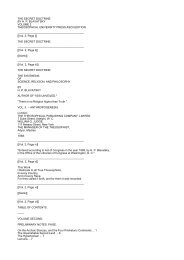Create successful ePaper yourself
Turn your PDF publications into a flip-book with our unique Google optimized e-Paper software.
Plate III.<br />
Sacred Texts Egypt Index Previous Next<br />
PLATE III.<br />
Vignette: Scene <strong>of</strong> <strong>the</strong> weighing <strong>of</strong> <strong>the</strong> Heart <strong>of</strong> <strong>the</strong> <strong>Dead</strong>. Ani and his wife enter <strong>the</strong> Hall <strong>of</strong> Double Law<br />
or Truth, wherein <strong>the</strong> heart, emblematical <strong>of</strong> <strong>the</strong> conscience, is to be weighed in <strong>the</strong> balance against <strong>the</strong><br />
fea<strong>the</strong>r, emblematical <strong>of</strong> law. Above, twelve gods, each holding a sceptre are seated upon thrones before<br />
a table <strong>of</strong> <strong>of</strong>ferings <strong>of</strong> fruit, flowers, etc. Their names are: Harmachis, "<strong>the</strong> great god within his boat";<br />
Tmu; Shu; Tefnut, "lady <strong>of</strong> heaven"; Seb; Nut, "lady <strong>of</strong> Heaven" Isis; Nephthys; Horus, "<strong>the</strong> great god";<br />
Hathor, "lady <strong>of</strong> Amenta"; and Sa. Upon <strong>the</strong> beam <strong>of</strong> <strong>the</strong> scales sits <strong>the</strong> dog-headed ape which was<br />
associated<br />
[1. A name <strong>of</strong> <strong>the</strong> underworld.<br />
2. Or Sexet-Anru, a division <strong>of</strong> <strong>the</strong> Sexet-hetepu (see Plate XXXV.), <strong>the</strong> Elysian fields wherein <strong>the</strong> souls <strong>of</strong> <strong>the</strong> blessed<br />
were supposed to reap and sow.<br />
3. In British Museum papyrus No. 9901 <strong>the</strong> goddess Maat is seated on <strong>the</strong> centre <strong>of</strong> <strong>the</strong> beam <strong>of</strong> <strong>the</strong> balance. The double<br />
Maat goddesses are at times represented standing beside <strong>the</strong> balance to watch <strong>the</strong> result <strong>of</strong> <strong>the</strong> weighing, and at <strong>the</strong> same<br />
time Maat is also placed in <strong>the</strong> scale to be weighed against <strong>the</strong> heart <strong>of</strong> <strong>the</strong> deceased (Fig. x) (see Naville, Todtenbuch, Bd.<br />
I., Bl. 136, Pa.). {footnote page 256} In <strong>the</strong> papyrus <strong>of</strong> Qenna <strong>the</strong> head <strong>of</strong> Anubis is on <strong>the</strong> beam, and <strong>the</strong> ape, wearing disk<br />
and crescent, is seated upon a pylon-shaped pedestal beside <strong>the</strong> balance (Fig. 2). Ano<strong>the</strong>r vignette shows Horus holding<br />
Maat in his band, weighing <strong>the</strong> heart in <strong>the</strong> presence <strong>of</strong> <strong>the</strong> Maat goddesses, and Anubis, holding <strong>the</strong> deceased by <strong>the</strong> hand,<br />
presents <strong>the</strong> heart to Osiris while Isis and Nephthys in <strong>the</strong> form <strong>of</strong> apes sit near (Fig. 3).<br />
]<br />
{p. 256}<br />
with Thoth,[1] <strong>the</strong> scribe <strong>of</strong> <strong>the</strong> gods. The god Anubis, jackal-headed, tests <strong>the</strong> tongue <strong>of</strong> <strong>the</strong> balance, <strong>the</strong><br />
suspending bracket <strong>of</strong> which is in <strong>the</strong> form <strong>of</strong> <strong>the</strong> fea<strong>the</strong>r The inscription above <strong>the</strong> head <strong>of</strong> Anubis<br />
reads:--"He who is in <strong>the</strong> tomb saith, pray <strong>the</strong>e, O weigher <strong>of</strong> righteousness, to guide (?) <strong>the</strong> balance that<br />
it may be stablished.'" On <strong>the</strong> left <strong>of</strong> <strong>the</strong> balance, facing Anubis, stands Ani's "Luck" or "Destiny," Shai<br />
and above is <strong>the</strong> object called mesxen which has been described[2] as "a cubit with human head," and<br />
which is supposed to be connected with <strong>the</strong> place <strong>of</strong> birth. Behind <strong>the</strong>se stand <strong>the</strong> goddesses Meskhenet<br />
and Renenet: Meskhenet[3]<br />
[1. In <strong>the</strong> papyrus <strong>of</strong> Sutimes (Naville, Todtenbuch, Bd. I., Bl. 43) <strong>the</strong> ape is called neb xemennu ut a maa, "Lord <strong>of</strong><br />
http://www.sacred-texts.com/egy/ebod/ebod15.htm (1 <strong>of</strong> 4) [8/10/2001 11:25:06 AM]

















